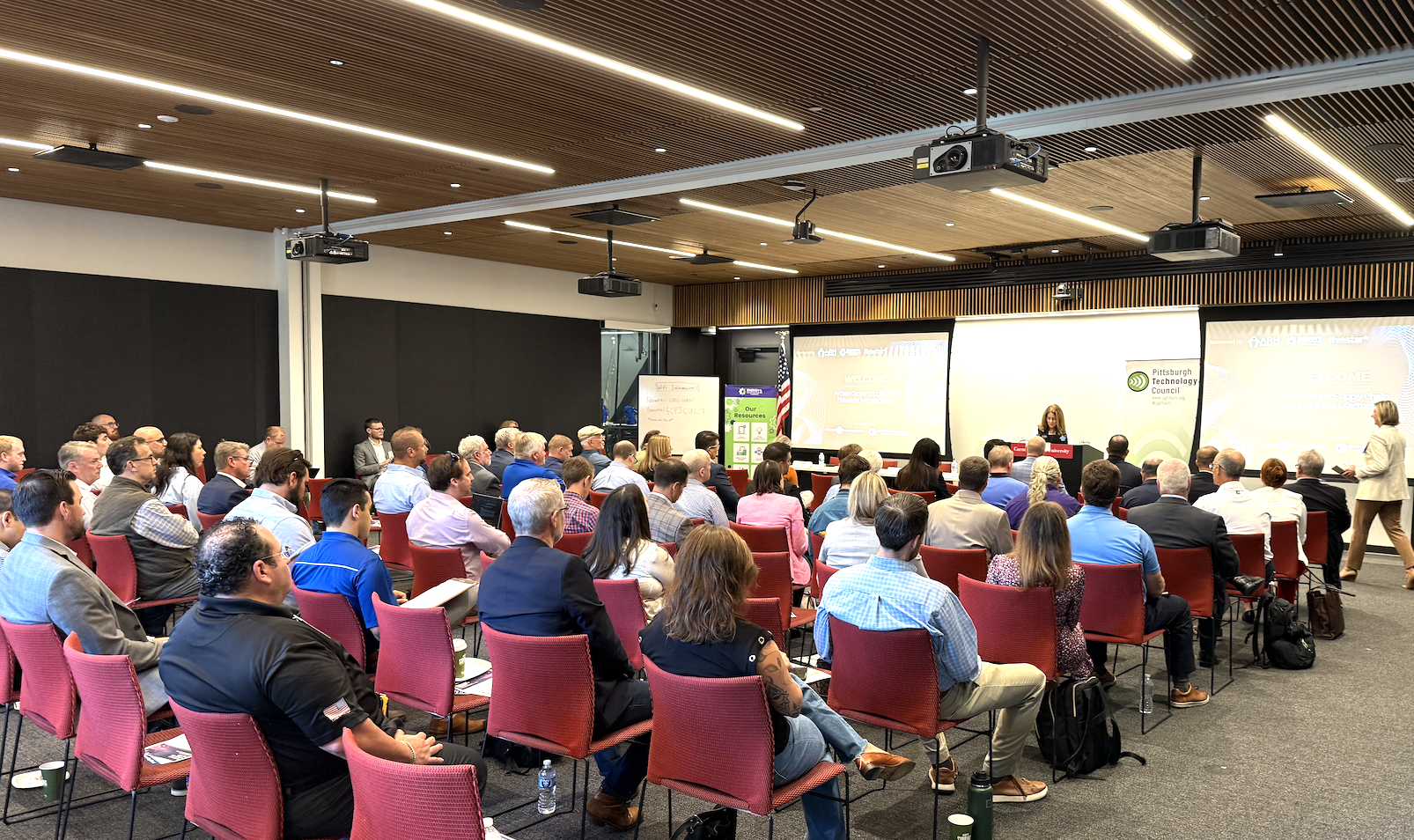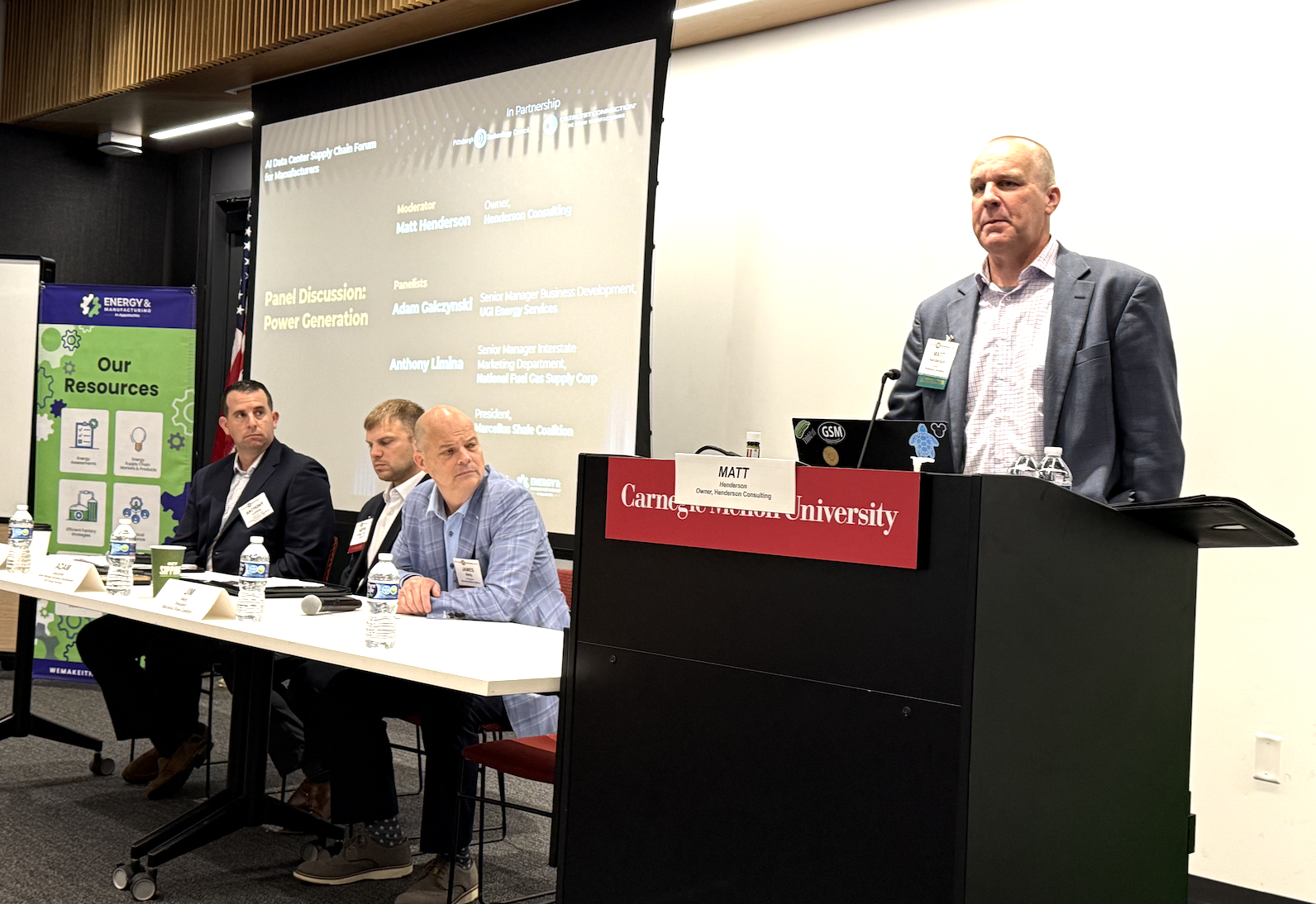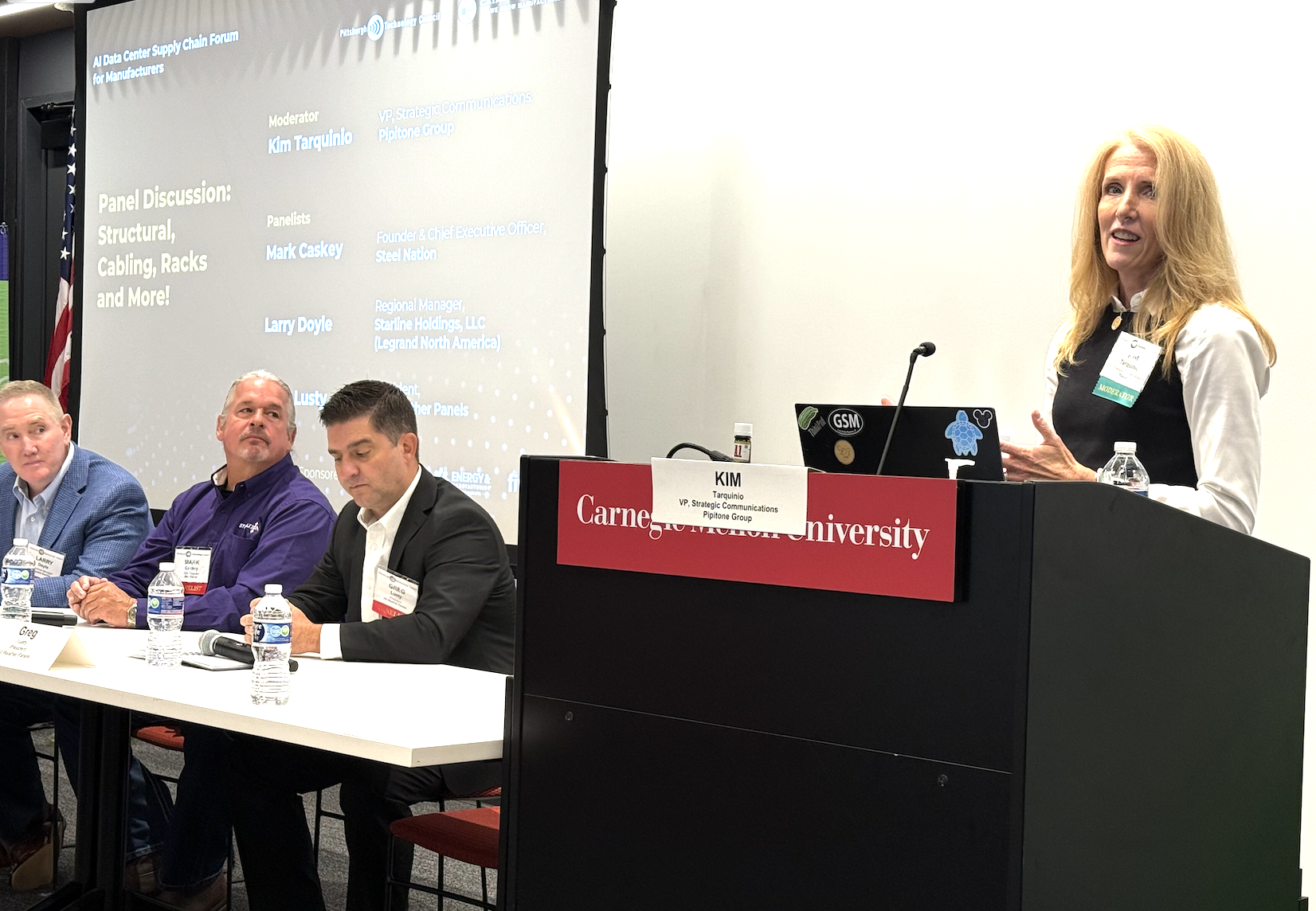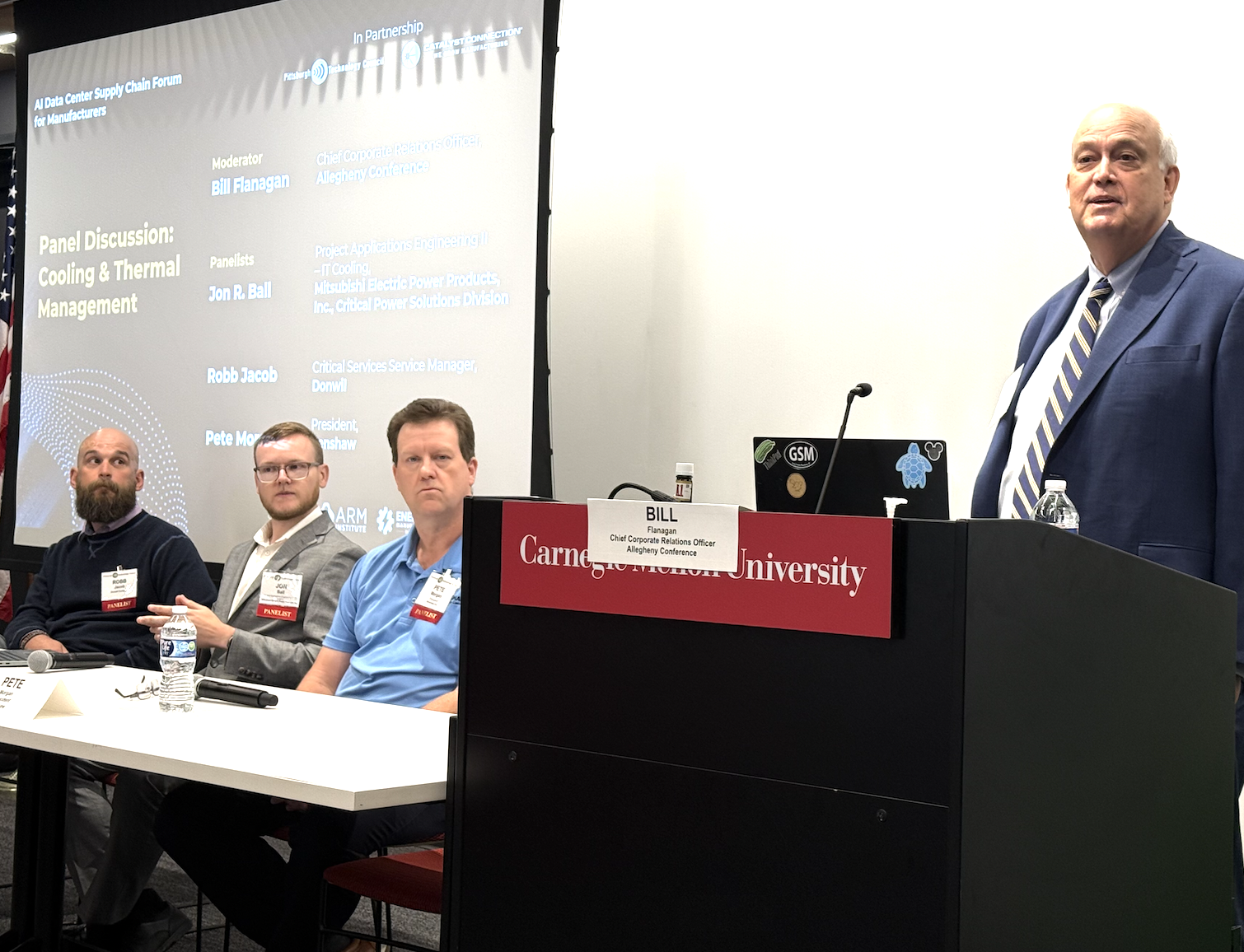Unlocking Opportunities in the AI Data Center Supply Chain
 As industries continue to embrace artificial intelligence (AI) and data-driven technologies, data centers have emerged as vital infrastructure supporting this digital revolution.
As industries continue to embrace artificial intelligence (AI) and data-driven technologies, data centers have emerged as vital infrastructure supporting this digital revolution.
The Catalyst Connection and Pittsburgh Technology Council AI Data Center Supply Chain Forum for Manufacturers brought together industry leaders to explore how manufacturers can adapt and thrive in this rapidly evolving ecosystem. Featuring three panel discussions—Cooling & Thermal Management, Structural, Cabling, Racks, and More!, and Energy Resources to Power AI Data Centers—the forum provided insights into the supply chain challenges, innovations, and opportunities surrounding next-generation data center development.
This overview distills the key discussions and actionable takeaways from these panels, presenting a roadmap for manufacturers to position themselves in this burgeoning market.
Panel Discussion 1: Energy Resources to Power AI Data Centers
 The immense energy demands of AI-driven data centers were examined, including strategies to harness various energy sources and ensure sustainability.
The immense energy demands of AI-driven data centers were examined, including strategies to harness various energy sources and ensure sustainability.
“For energy providers, this is about reinventing the business model,” said panelsit Anthony Limina, Sr. Manager Interstate Marketing Department, National Fuel Gas Supply Corp. "The AI sector is not just looking for power; they're looking for long-term partnerships focused on operational scalability and reduced carbon footprints."
Highlights:
-
AI Driving Energy Demand: AI-driven facilities require a tremendous amount of electricity, with Pennsylvania emerging as a key focus due to its rich natural gas resources.
-
Hybrid Energy Solutions: While natural gas holds a central role, there was acknowledgment of the need for a multi-source approach, including renewables, to power these facilities sustainably.
-
Infrastructure Partnerships: Manufacturers were encouraged to leverage existing energy infrastructures and develop new capabilities aligned with their core competencies.
-
Global AI Competition: The race to lead the AI economy was framed as contingent on both operational efficiency and energy resource readiness.
Key Takeaways for Manufacturers:
-
Collaborate with energy providers to align new facilities with available power grids and future renewables.
-
Support hybrid energy strategies, integrating traditional and renewable sources for long-term sustainability.
-
Focus on energy-efficient components to help reduce overall consumption within facilities.
-
View AI-driven data center development as a strategic industry—invest in partnerships that enhance competitiveness in the global AI economy.
Panel Discussion 2: Structural, Cabling, Racks, and More!
 Manufacturing innovations for structural systems, insulated metal panels, and raised flooring aimed at optimizing durability, efficiency, and scalability.
Manufacturing innovations for structural systems, insulated metal panels, and raised flooring aimed at optimizing durability, efficiency, and scalability.
“Data centers are about scalability—not only in computational capacity but also in how their infrastructure supports ongoing growth,” said panelist Larry Doyle, REgional anager, Starline Holdings.
Highlights:
-
Scalable Structural Design: Structural systems are evolving to support both high loads and modular reconfigurations, enabling data centers to adapt to future growth.
-
Insulated Metal Panels (IMPs): IMPs were emphasized for their dual role in insulation and structural integrity, offering high thermal performance and ease of installation.
-
Raised Flooring: These systems provide cooling benefits, cable management flexibility, and a platform for modular construction, making them a cornerstone of efficient facility design.
-
Supply Chain Speed: Regional and localized supply chains were discussed as critical to streamlining construction timelines while maintaining quality.
Key Takeaways for Manufacturers:
-
Innovate products that prioritize scalability and modularity for evolving data center needs.
-
Focus on seamless system integration—ensure structural and thermal components complement one another.
-
Incorporate precision-engineered materials like IMPs to balance durability and insulation.
-
Engage with regional supply chain partners to reduce lead time for core components.
Panel Discussion 3: Cooling & Thermal Management
 Innovations in cooling systems, UPS integration, precision control, and HVAC ductwork were explored to address the challenges posed by AI-generated heat loads.
Innovations in cooling systems, UPS integration, precision control, and HVAC ductwork were explored to address the challenges posed by AI-generated heat loads.
“In the past, we could rely on simple air-cooled systems—roll in some fans, and you were good for a couple of days,” explained panelist Robb Jacob, criticla Services Manager, Donwil. “But now? A single second of thermal runaway can fry millions of dollars’ worth of equipment. Failure is simply not an option.”
Highlights:
-
Liquid Cooling: The shift to liquid cooling systems was identified as critical for managing high-density AI workloads, which generate extreme heat levels and demand unparalleled efficiency.
-
Precision Control: Advanced monitoring systems ensure that temperature and airflow optimization can be managed in real time, preventing thermal runaway and ensuring uptime.
-
Reliability and Redundancy: Redundant cooling paths and fail-safe systems were highlighted as essential for ensuring continuous operations.
-
Aftermarket Services: Manufacturers were encouraged to provide ongoing maintenance and support to maximize long-term efficiency and create recurring value.
Key Takeaways for Manufacturers:
-
Develop scalable liquid cooling solutions tailored for high-density racks.
-
Integrate smart controls for real-time monitoring and precision in thermal management.
-
Design systems with redundancy and robust fail-safes to minimize downtime.
-
Establish service models for aftermarket maintenance and long-term client partnerships.
Manufacturer Opportunities in the AI Data Center Supply Chain
Across all panels, several overarching themes emerged that manufacturers can use to gain strategic advantages in this market:
-
Adapt Existing Solutions: Manufacturers don’t necessarily need to pivot their core business models entirely—many existing competencies (e.g., production of technical components, metal fabrication, modular design expertise) can be leveraged for data center applications.
-
Collaborate Regionally: Localized supply chains and regional manufacturing partnerships were consistently identified as key enablers for speed and operational efficiency.
-
Sustainable Scalability: As AI applications scale at an extraordinary pace, manufacturers who anticipate future needs—designing modular and sustainable systems—can secure their place in future facility builds and retrofits.
-
Proactive Engagement with Technological Trends: Cooling, energy efficiency, and integrated design elements are evolving rapidly. Staying ahead of these innovations will allow manufacturers to claim their position as indispensable partners in the supply chain.
The AI Data Center Supply Chain Forum for Manufacturers provided a comprehensive look at how this booming industry is reshaping infrastructure design and supply chain dynamics. From cooling technologies to structural adaptations and energy innovations, manufacturers have the opportunity to deliver value at every stage of data center construction and operation.
By focusing on scalability, efficiency, and sustainability, manufacturers can solidify their contributions to these critical facilities and position themselves at the forefront of the AI-powered future. As the forum reiterated, the race to lead the global AI economy depends not only on technological innovations but also on the physical infrastructure powering them—and this is where manufacturers truly shine.
Connect!
If you are looking to get more involved in the burgeoning data center and AI infrastructure industry the Pittsburgh Technology Council has created a new community to help you tap into the many opportunities. Learn more here. Discover Catalyst Connections services here.